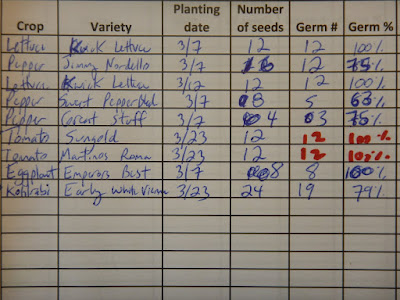One problem I am currently dealing with is that it's time to plant tomatoes indoors and I am running out of room under my grow lights. I have a whole flat of lettuce that needs to move out to make room for my valuable tomato seedlings. After much reading this winter, I found some options for extending my season, and with these farm additions I can move some plants out and even start seeds outdoors now and could be harvesting cold-loving crops earlier in the spring and then again until Thanksgiving or later. Of course a heated greenhouse is ideal for growing year-round, but these are some easy, inexpensive options I'm trying out this year.
Cold Frame
A cold frame can be used for hardening off plants early in the year and growing veggies late into the fall. This project took a few hours, but other than buying the hinges, I was able to repurpose wood and other leftover supplies from my garage.
 |
| The plan for the cold frame was found in this book. |
 |
A thermometer helps monitor the environment inside the cold frame, since temperatures can really heat up on even a very cool but sunny day.
|
I placed the cold frame in a sunny spot facing south. When nights get really chilly this spring, my plan is to cover the cold frame with an old blanket and place a jug of hot water in the frame with the plants to slow the temperature drop overnight.
Hoop House
After building the cold frame, I decided to try additional cold weather growing options and see which ones worked best. According to the UW Extension, a hoop house can extend the growing season by 6-8 weeks, and I've noticed that most of the CSA farms around use them. My goal for the hoop house is to grow cool season veggies early in the spring (and then later in the fall), specifically the fresh spinach and salad greens I've been craving.
After I worried for several days about how to do it (I winged it since I didn't have written instructions for my specific plan) it turned out to be one of the easiest garden modifications I've made. The new hoop house sits over one of my 4' x 8' beds, and when the spring heats up it can be easily removed and stored away until fall.
The simple frame consists of 4 PVC pipes. The ground is soft right now, so I was able to drive them into the ground inside of the raised bed for stability. I made three hoops and used one across the top, and all of these were zip tied together. I also used wood stakes (two on each end) to add stability and keep the hoop house upright.
 |
| Hoops over the raised bed. |
 |
| I found the plastic at my local farmer's co-op. |
 |
| This is a temporary structure, so rocks hold down the plastic sheeting. |
 |
| When the day heats up, the cover is easily rolled up and clipped. |
Row Cover
Another trick I'm trying is row cover, which should provide protection down to 28F. I'm going to plant early in the community garden, and the row cover should hopefully provide some protection not only from cold weather, but also from hungry bunnies and birds. For early season crops like salad greens, the cover can be left on the plants 24/7 through harvest, which is a big bonus since I don't make it out the community garden every day. For especially cold nights, the row cover can also be used inside of the hoop house to add a second layer of protection.
 |
| Be sure to shop around. Prices vary widely depending on where you shop. |






















